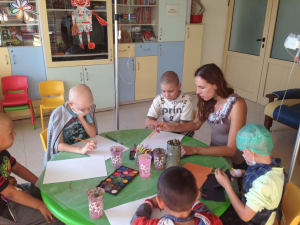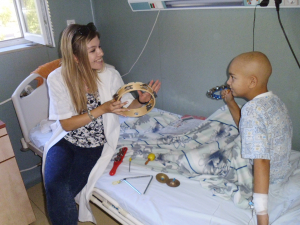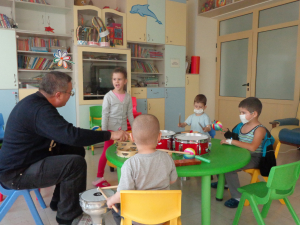
ARTON PROGRAM - The therapeutic power of the group
Creative projects involving group work - general musical performance or group painting, collage, sculpture - are useful in helping to explore and strengthen social...
Self-esteem is crucial to children’s academic achievement, participation, engagement in activities, social relationships, and, ultimately, their sense of wellbeing.
Children low in self-esteem tend to be shy and introverted, with self-imposed limitations and a fixed mindset. Those high in self-esteem are enthusiastic, active, feel a greater sense of worth, and, perhaps most importantly, feel comfortable with who they are (Keshky & Samak, 2017; Dweck, 2017).
It follows that supporting a child as they grow and develop their self-esteem can improve their psychological wellbeing and what they get out of, and put into, life.
This article explores self-esteem in child development and offers counselors, therapists, and parents tools to foster a sense of worth.
Self-esteem is a measure of how we see ourselves–our sense of self-worth.
Being high in self-esteem makes us feel valued, boosting our self-belief, ability to perform, subjective wellbeing, and overall psychological health. It facilitates our growth as individuals and provides a buffer against setbacks and failures (Ellis, 2019; Jordan, Zeigler-Hill, & Cameron, 2017).
Low self-esteem has the opposite effect, to the point where we may not even like who we are (Abdel-Khalek, 2016; Orth, 2017).
And, far from being fixed, self-esteem “waxes and wanes through life” (Robins & Trze?niewski, 2005). Although relatively high in young children–possibly due to unrealistic positive self-views–it lowers as they grow, perhaps partly due to a poor self-image.
Self-esteem then climbs through adulthood, peaking at around the age of 60, before finally decreasing in old-age (Robins & Trze?niewski, 2005; Orth, 2017).
Self-esteem plays a crucial role in children’s happiness, sense of worth, and overall development. After all, children higher in self-esteem feel more confident and capable. They are proud of who they are and what they achieve and are comfortable asking for help and standing up for themselves (Cunningham, 2019).
Higher self-esteem in child development promotes:
A lack of positive feedback or appropriate support can lead to low self-esteem and:
By adolescence, self-esteem is a factor in health and welfare, and a predictor for students’ academic achievement (Nguyen, Wright, Dedding, Pham, & Bunders, 2019). Indeed, elevated self-esteem leads to more positive outcomes–now and later–identified by occupational success, better social relationships, improved coping skills, positive perception by peers, and an increased sense of wellbeing.
On the other hand, low self-esteem is related to antisocial behavior, substance abuse, and even, catastrophically, suicide cases.
Without a doubt, creating an environment that supports the growth of self-esteem, such as setting goals, has far-reaching benefits. When successful, children with appropriate support can see that hard work pays off, and they are ready for new challenges. When they fail, they bounce back and still feel good about themselves.
Self-esteem is a highly complex psychological construct.
At both a state and a trait level, its influences include genetic, environmental, and many other psychological factors that promote or reduce its effectiveness (Bleidorn, Hufer, Kandler, Hopwood, & Riemann, 2018).
However, while its exact makeup and interrelationships with other elements of our personality remain unclear, research has uncovered several causes of low self-esteem:
Praise
Perhaps counterintuitively, praise can be a significant factor in low self-esteem (Brummelman, Nelemans, Thomaes, & Orobio de Castro, 2017). Findings suggest that “overly positive, inflated praise” sets unattainable standards for children and can ultimately reduce self-esteem while increasing narcissistic tendencies. The answer appears to be in praising effort rather than ability.
Peer victimization
Being the victim of bullying, aggressive, and hostile behavior results in several adverse outcomes, including low self-esteem. The effect can be long-lasting, and those already lacking in self-esteem are more susceptible than others.
High body mass index (BMI)
Research has identified that high BMI in children can be a precursor to low self-esteem. Reducing BMI may positively affect feelings of self-worth (Hesketh, Wake, & Waters, 2004).
Academic stress
Depression, anxiety, and academic stress are factors in low self-esteem and poor quality of life (Nguyen et al., 2019).
Negative feedback
The comments and communication that children receive from their parents or caregivers have a large effect on self-esteem. For example, relentless negative feedback (you are stupid, useless, lazy, etc.), suggesting life would be better without them, ignoring or treating children as an annoyance, and unfavorable comparisons with other children can all damage a child’s sense of self-worth.
Research has also identified several indirect factors that appear to impact a child’s self-esteem, including gender, performance at school, parents’ education level and employment status, and socioeconomic status (Nguyen et al., 2019).
Self-esteem is vital for children’s confidence in themselves and their ability to overcome challenges (Cunningham, 2019).
Participation and overcoming problems, asking for help, and receiving appropriate support are all positive takeaways that build self-esteem and self-confidence, whether successful or not. The caregiver’s challenge is to balance between being supportive, overprotective, and realistic.
The following are all factors that can positively influence the growth of a child’s self-esteem and encourage them to believe in themselves:
Self-esteem is not fixed; it can be changed. As a parent, teacher, or therapist, there are ways to work with children to grow their domain-specific and, over time, their global self-esteem (Brown, Dutton, & Cook, 2001).
The following activities are not all specific to self-esteem, but help children create a flexible, growth-oriented mindset by focusing on being confident in who they are.
Tailor each of the following activities for the age of the child and the situation:
Create a box of memories
Find a big enough box to store certificates, pictures, and objects they have made at school, at home, or in youth groups.
Discuss with the child what sorts of things to place in the box. Suggest that it includes not only medals or awards for winning, but also certificates or recognition received for hard work or extra effort put in.
Place objects in the box over a semester or school year.
Return and review the box’s contents over the months and ask the child to remember how hard they worked, the obstacles overcome, and the difficulties faced.
Consider what was challenging. How did they overcome it? How does it compare with challenges now?
Design affirmations
Work with the child individually or in a group to design affirmations. Write the positive statements down in a journal or separately on cards and stick them to a whiteboard or fridge door.
Encourage the child to regularly revisit the affirmations–perhaps daily at first–and build a self-narrative that will enhance their self-esteem.
Strength in differences
Often we feel pressure to look, behave, think, and feel the same as others. But while it is essential to recognize the similarities we all share, we should also register our differences and identify our strengths.
Discuss with the child the importance of being yourself while recognizing what makes them unique.
Ask the child to:
Explain to the child that we must remind ourselves how special, unique, and amazing we all are.
Work with them, using their words and some prompting, to complete the Things I Like About Me exercise.
Ask the child to spend some time reviewing the list and return to it over the days and weeks ahead to reflect and increase their sense of self-worth.
My ‘love letter’ to myself
Building on the above exercise, identify and celebrate the child’s strengths using the My ‘Love Letter’ to Myself exercise.
The output is a set of statements, each beginning with “I am…” that contains the child’s positive qualities, how they benefit themselves and others, and how to foster them going forward.
Work together to understand how the child could use their strengths more often.
Self-love journal
Journaling can be an interesting and enlightening exercise that can be a great way to think about yourself, relive past successes, and reflect on strengths and positive qualities.
Use these Self-Love Journal prompts to introduce more self-directed kindness and compassion into the child’s life. Review the journal at the end of each week and celebrate the successes and achievements–large or small.
The following worksheets provide tools to use with individual and groups of children to build self-esteem, either directly or by strengthening other, related psychological factors:
Make a manifesto for YOU
In the excellent Dare to Be You, Matthew Syed describes a plan he came up with in his youth to find and follow his own path, question the world he found himself in, and change what wasn’t working well in his life. He describes his plan as “a manifesto for daring to be ME” (Syed & Triumph, 2020).
Working with the child, use the Make a Manifesto for YOU worksheet and create a set of values or statements according to which they might like to live.
Develop a growth mindset
A growth mindset embraces the view that skills and abilities can develop over time with practice and that there is more than one way to tackle a challenge. A fixed mindset unhelpfully adopts the belief that skills and abilities are set, and certain obstacles cannot be overcome (Dweck, 2017).
Whether a child adopts a fixed or growth mindset profoundly affects the life they lead and the adult they become. Adopting a growth mindset means they are ready to step out of their comfort zone, experience change, embrace it, and learn.
Use the following questions (modified from Dweck, 2017) to build an understanding of what a fixed and a growth mindset look like, and what advantages each may have:
Fixed mindset Growth mindset
Do I want to look smart? Do I want to learn?
Do I avoid challenges? Do I embrace challenges?
Do I give up too easily? Do I persist, whatever is thrown at me?
Is effort fruitless and a waste of time? Is effort the path to being good at something?
Do I ignore useful feedback? Do I listen to and learn from criticism?
Do other people’s successes threaten me? Do I learn from others’ successes and feel inspired?
Ask the child, what are the advantages and disadvantages of a growth versus a fixed mindset? Can you think of examples where you showed both fixed and growth mindset thinking?
Self-acceptance meditation
Self-acceptance is a hallmark of accepting who you are and building a healthy relationship with the self.
The Self-Acceptance Meditation worksheet encourages acceptance of self despite weaknesses or deficiencies and can work well with older children or young adults.
Use the compassionate phrase “may I” to provide a loving-kindness perception of yourself.
Three Good Things
The following worksheet works well with all ages. It can be performed more formally and in writing for older children, or spoken out loud for younger ones – especially as an end-of-day routine, in bed, before going to sleep.
Try out the Three Good Things exercise a few times a week to improve feelings of wellbeing and see the positive in each day.
You can find even more self-esteem worksheets in this article, aimed at teens and adults.
Being different can be a source of low self-esteem for many children.
Parents and caregivers should spend time with their children, discussing similarities between all of us while noting we are also unique, with strengths individual to each of us.
After all, while we may look different, we all have hopes, fears, and things that make us happy.
The following tips are for dealing with a child with low self-esteem (modified from Newman, 2020). They overlap and complement one another but may, at times, seem at odds. The challenge is to find an appropriate balance for the child and the situation:
Translation, professional adaptation and re-posted from https://positivepsychology.com/

Creative projects involving group work - general musical performance or group painting, collage, sculpture - are useful in helping to explore and strengthen social...

In the ARTON Program our team of oncopsychologists, art therapists and music therapists develops the process of children's creativity as a process of...

In ARTON sessions, creating a piece of music or a song is an emotional experience of coping and satisfaction for the participating children. They make friends with...

Painting provides patients with a spontaneous, plastic method of depicting thoughts and experiences. Painting with paints is not as structured as with pencil or...










